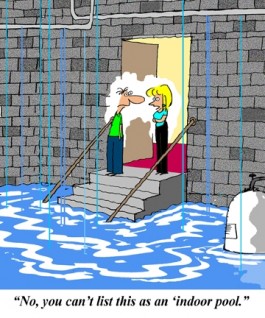Basement Water Damage Can Cost You More Than You Think
It always happens suddenly, and without warning … Toilets overflowing, household appliances malfunctioning, water pipes breaking, leaking roofs or windows … And now you have to make a decision: “Do I submit a claim to my insurance company? If it’s not a covered loss, do I try to clean it up myself?”
Here are some important things to keep in mind:
 Water in the Basement Can Cost You The Sale of Your Home
Water in the Basement Can Cost You The Sale of Your Home
- DON’T WAIT! The longer the affected areas are wet, the greater the amount of damage. Water doesn’t just sit there … it spreads. If carpeting is involved, it doesn’t take long for it to seep into the pad, the subflooring, then up the walls or paneling. Once those are damp, the potential for mold and mildew growth is just hours away.
- DON’T EXPECT IT TO “Air-Dry!” One of the most common problems encountered comes from the homeowners decision to “see if it’ll just dry out by itself.”
Because of the potential health hazards, that means you have to discard the carpet and pad, and replace with new – An expensive proposition that could have been avoided!
Even if it’s a “covered loss,” your insurance may deny your claim because you waited too long!
Water in the Basement Can Cost You The Sale of Your Home
THINKING ABOUT SELLING YOUR HOME IN THE FUTURE? Then keep in mind that you have to disclose information on past water damage, and you will have to prove it was properly remediated. If mold is present in the home, the potential buyer may not be able to obtain insurance! You may not even be able to sell your home! Therefore, don’t take any chances! Call a Minnesota Water Damage Restoration Expert right away! The key is getting it dry as fast as possible!
Preventing Water Damage In Your Home
Unexpected water in your basement can damage walls and floors, destroy carpeting, ruin furniture and lead – pretty quickly – to mold. And perhaps the most upsetting of all: As basements are so often used for storage, water downstairs can ruin irreplaceable items like photo albums, antiques, and family heirlooms.
The first signs of water damage might seem trivial: a drip here, a drop there – nothing that can’t be dried with a towel.
But warnings like water stains on the ceilings or a leak under the kitchen sink can lead to real problems like a weakened roof or rotten floorboards. Burst pipes can damage your furniture and other personal possessions, and flooding can very quickly lead to problems with mold.
Why take a chance? Learn where your home is most likely to suffer water damage, and what you can do to help prevent it.


